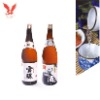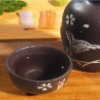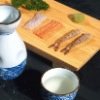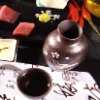- Other Food & Beverage[10]
- Sauce[10]
- Rice Wine[7]
- Dried Vegetables[4]
- Single Spices & Herbs[4]
- Contact Person : Mr. Li Jianbing
- Company Name : Dalian Tianpeng Food Co., Ltd.
- Tel : 86-411-84507182
- Fax : 86-411-84610258
- Address : Liaoning,Dalian,3 NO.2 FUZHOUCHENG INDUSTRIAL ZONE WAFANGDIAN
- Country/Region : China
- Zip : 116021
Japanese style Sake, rice wine, cooking wine, pure rice sake OEM
SAKE
Sake is also referred to in English as a form of rice wine. However, unlike true wine, in which alcohol is produced by fermenting the sugar naturally present in fruit, sake is made through a brewing process more like that of beer. To make beer or sake, the sugar needed to produce alcohol must first be converted from starch. But the brewing process for sake differs from beer brewing as well, notably in that for beer, the conversion of starch to sugar and sugar to alcohol occurs in two discrete steps, but with sake they occur simultaneously. Additionally, alcohol content also differs between sake, wine, and beer. Wine generally contains 9–16% alcohol[1] and most beer is 3–9%, whereas undiluted sake is 18–20% alcohol, although this is often lowered to around 15% by diluting the sake with water prior to bottling.The origins of sake are unclear; however, the earliest written reference to use of alcohol in Japan is recorded in the Book of Wei, of the Records of Three Kingdoms. This 3rd century Chinese text speaks of the Japanese drinking and dancing. Sake is also mentioned several times in the Kojiki, Japan's first written history, compiled in 712. People used sake for spiritual functions because people who drink it get a fever and what they believed to be a "spiritual high
By the Asuka period, true sake—made from rice, water, and mold Aspergillus oryzae)—was the dominant alcohol. In the Heian period, sake began to be used for religious ceremony and people seldom drank it. Sake production was a government monopoly for a long time, but in the 10th century, temples and shrines began to brew sake, and they became the main centers of production for the next 500 years. The Tamon-in Diary, written by abbots of Tamon-in temple from 1478 to 1618, records many details of brewing in the temple. The diary shows that pasteurization and the process of adding ingredients to the main fermentation mash in three stages were established practices by this time
n the 16th century, technique of distillation was introduced into the Kyushu district from Ryukyu, and started brewing shochu called "Imo—sake", sold at the central market in Kyoto. And, powerful daimyo imported various liquors and wine from China.
The rice used for brewing sake is called shuzo kotekimai (sake rice). The grain is larger, stronger, and contains less protein and lipid than ordinary rice eaten by Japanese. The rice has a starch component called shinpaku in the center of the grains. Since sake made from rice containing purely starch has a superior taste, the rice is polished to remove the bran. If a grain is small or weak, it will break in the process of polishing. This rice is only used for making sake because it is unpalatable for eating; it is clearly distinguished from rice for the latter purpose. There were at least 80 types of sake rice in Japan. Among these, Yamadanishiki, Gohyakumangoku, Miyamanishiki and Omachi rice are very popular.
The rice used for brewing sake is called shuzo kotekimai (sake rice). The grain is larger, stronger, and contains less protein and lipid than ordinary rice eaten by Japanese. The rice has a starch component called shinpaku in the center of the grains. Since sake made from rice containing purely starch has a superior taste, the rice is polished to remove the bran. If a grain is small or weak, it will break in the process of polishing. This rice is only used for making sake because it is unpalatable for eating; it is clearly distinguished from rice for the latter purpose. There were at least 80 types of sake rice in Japan. Among these, Yamadanishiki, Gohyakumangoku, Miyamanishiki and Omachi rice are very popular.
Water is the one of the important ingredients for making sake. Rigid restrictions are observed for the concentrations of certain chemical substances which can affect the taste and quality of sake. The water used is almost always groundwater or well water. Urban breweries usually import water from other areas, because of the difficulty of getting water of sufficient quality locally.
Japanese style Sake, rice wine, cooking wine, pure rice sake OEM







